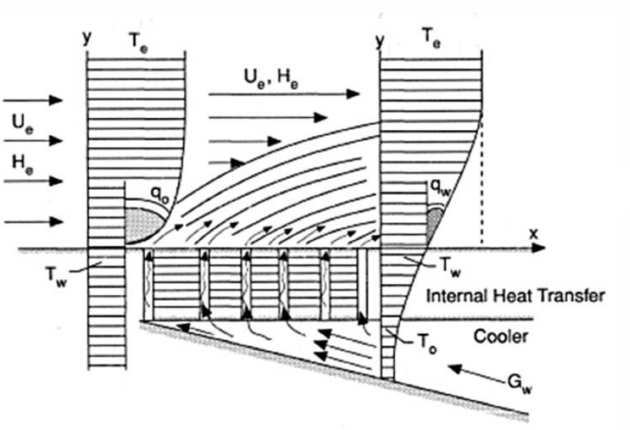Transpiration Cooling Systems for Jet Engine Turbines and Hypersonic Flight
Name: Dr Laura Larrimbe
Supervisors: Dr Luc Vandeperre and Prof Bill Lee
Sponsor: EPSRC
Thermal protection systems for hypersonic flight are expected to have to operate with component temperatures in excess of 2000 ºC, leaving only a small group of materials with sufficient high melting points. Ultra High Temperature Ceramics (UHTC) have become the lead candidates for the development of such protection systems also due to their high thermal conductivity which enables heat to be conducted laterally thus reducing the maximum temperatures of the sharp leading edge. The basis of transpiration cooling is the introduction of a cool layer of gas between the component and the hot freestream flow, reducing the heat flux to the material (Figure 1).

Figure 1. Transpiration cooling system
UHCT’s with controlled porosity are suitable for application in transpiration cooling systems. This work addresses the manufacturing of innovative porous UHTCs by establishing a densification route which does not require pressure and allows producing the components in the correct shape without requiring extensive machining or large amounts of material loss. Samples of ZrB2 with homogenous porous structures were manufactured by partial sintering or by addition of different volume fractions of fugitive inclusions, using starch as a pore former (Figure 2).

Figure 2. Pressureless sintered ZrB2 using starch as a fugitive agent
Characterization of the sintered porous UHTCs was focussed on measuring systematically the relationship between pore structure, porosity and some properties such as thermal conductivity, strength or flow. All this information enables to select the most relevant candidate which capable to maintain excellent thermal and structural properties whilst moving to a high porosity.
Further future research will focus on the study of pores generated by 3D printing organic channel structures, followed by gel casting of ceramic around these preforms.


